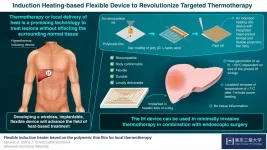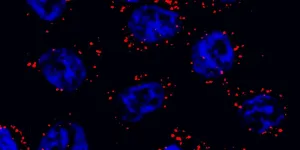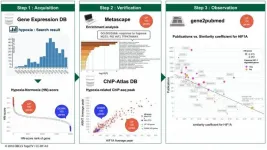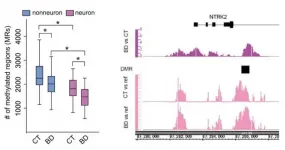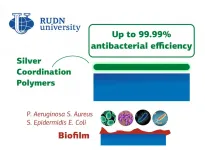Single-particle studies point the way toward next-generation light displays
Researchers from the University of Tsukuba experimentally tested a long-presumed, yet never confirmed, light-emission hypothesis on a molecular level, with applications in many advanced optical technologies
2021-06-09
(Press-News.org) Tsukuba, Japan - Holographic displays help add a three-dimensional--and thus more life-like--feel to what would otherwise appear as a two-dimensional image. Now, researchers in Japan have tested how this may work on a supramolecular level; such tests could lead to improved displays.
Commonly, one cannot overlay a certain type of molecular component that underlies helically arranged liquid crystals onto their molecular mirror images, much like a person cannot overlay their two hands and have them match up exactly without flipping one over. Molecules with this property are described as "chiral." Some materials make use of the principle of chirality to rotate light in a plane perpendicular to the direction of the light wave, known as circular polarization. Understanding how such materials work may help researchers develop, for example, advanced holography or optical coding.
Researchers have long postulated that helical molecular assemblies, upon being illuminated, emit circularly polarized light in a spatially anisotropic manner that depends on the three-dimensional morphology and orientation of the assemblies. However, this orientation presumption hasn't been conclusively tested on a molecular level. Doing so should help researchers develop improved displays and better understand the optical principles that underlie such displays.
In a study recently published in Journal of the American Chemical Society, researchers from the University of Tsukuba demonstrated the spatial distribution of circularly polarized light emitted from a micro-spherical molecular assembly composed of a chiral polymer.
"The constituent polymers spontaneously aggregate with each other in a helical manner with a micro-spherical morphology just by slow diffusion of methanol vapor into a chloroform solution of the chiral polymer," explains Professor Yohei Yamamoto, senior author. "This is essential to imparting maximum macroscopic order to the polymer assemblies, which is unattainable in solution or thin-film states."
Polarized optical microscopy imaging of the microparticles revealed the helical, or spiral-like, structure. From these microscopic observations, the team deduced that the atomic-scale chirality of the polymer defined the "handedness" or direction of the spiral texture of the microparticles. Picking up a single microparticle and observing it while rotating it in various ways confirmed this deduction.
"The spatial distribution of the circularly polarized fluorescence from individual particles substantially lacks rotational symmetry," says Professor Yamamoto. "This is attributable to the three-dimensionally anisotropic molecular stacking of the polymer that constitutes the microparticles."
Biological organisms frequently use helical stacking to fold proteins or nucleic acids--biological polymers. Such folding may be useful in computer algorithms, drug delivery, and other technologies. Researchers could be inspired by the findings reported here to incorporate three-dimensional color readout into nano-scale objects. In the meantime, researchers now have a new versatile tool for studying how one can use molecular structure to enhance the spatial properties of computer displays, lasers, and other everyday technologies.
INFORMATION:
[Attachments] See images for this press release:
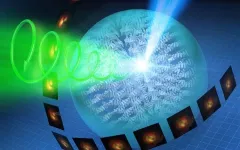
ELSE PRESS RELEASES FROM THIS DATE:
2021-06-09
Researchers from the Singapore University of Technology and Design (SUTD) have developed novel techniques, known as Automated Fibre Embedding (AFE), to produce complex fibre and silicone composite structures for soft robotics applications. Their work was published in IEEE Robotics and Automation Letters.
Many soft robot components, including sensors and actuators, utilise embedded continuous fibres within elastomeric substrates to achieve various functionalities. However, manual embedding of continuous fibres in soft substrates is challenging due to the complexities involved in handling precise layering, and ...
2021-06-09
Thermotherapy or heat treatment can help in treating lesions and other tissue injuries. For example, chemotherapy or radiotherapy, when combined with thermotherapy, kills tumorous cells more effectively. Thermotherapy is considered a promising approach for treating internal lesions, but the advancement in the field depends on the availability of patient-friendly heat-inducing devices capable of rapidly increasing the temperature of target tissues.
Current clinical practices around thermotherapy majorly employ heat-generating devices that are probed inside ...
2021-06-09
DALLAS - June 9, 2021 - A phenomenon in which an RNA named NORAD drives a protein named Pumilio to form liquid droplets in cells, much like oil in water, appears to tightly regulate the activity of Pumilio. A new study led by UT Southwestern scientists suggests that such RNA-driven "phase separation," in turn, protects against genome instability, premature aging, and neurodegenerative diseases, and may represent a previously unrecognized way for RNAs to regulate cellular processes.
"It's becoming more and more clear that phase separation is an important organizing ...
2021-06-09
A research team, led by Professor Kyoung-Duck Park in the Department of Physics at UNIST has succeeded in investigating and controlling the physical properties of naturally-formed nanoscale wrinkles in two-dimensional (2D) semiconductors. This is thanks to their previously-developed hyperspectral adaptive tip-enhanced photoluminescence (a-TEPL) spectroscopy. This will be a major step forward in developing paper-thin, ultra-flexible displays.
Wrinkles are an inevitable structural deformation in 2D semiconductor materials, which gives rise to spatial heterogeneity in material properties, according to the research team. Such structural deformation has long been considered one of the top technical challenges in semiconductor manufacturing, as this would harm the uniformity ...
2021-06-09
Young clownfish living closest to shore are dying faster than those further offshore because they are being exposed to artificial lighting, says an international research team.
Working on the reefs around Moorea in French Polynesia, scientists from France, the United Kingdom, Chile and Australia found that nearshore juvenile clownfish living in anemones under lights had higher mortality than juveniles in anemones not exposed to artificial light.
The scientists also found that the surviving clownfish grew 44 per cent more slowly than clownfish under natural lighting conditions.
Professor Stephen Swearer, a marine ecologist, from the University of Melbourne, ...
2021-06-09
Scientists have leapt over the emerging problem of publication bias within genetic research by performing a meta-analysis of publicly available databases of 'transcriptomes', or the full range of messenger RNA molecules produced by an organism. Researchers from Hiroshima University applied the technique to their own field--the study of the genes that are activated when an organism experiences low-oxygen conditions--but it should also be applicable in any other fields that make use of the transcriptome, providing a powerful weapon against the threat posed by publication bias.
The meta-analysis technique ...
2021-06-09
A research collaboration based in Kumamoto University, Japan has revealed the DNA methylation status of gene transcriptional regulatory regions in the frontal lobes of patients with bipolar disorder (BD). The regions with altered DNA methylation status were significantly enriched in genomic regions which were reported to be genetically related to BD. These findings are expected to advance the understanding of the pathogenesis of BD and the development of therapeutic drugs targeting epigenetic conditions.
BD is a mental disorder that affects about 1% of the population and requires long-term treatment. Epidemiological studies have ...
2021-06-09
RUDN University chemist with his colleagues from Portugal has developed two types of coating based on new coordination polymers with silver. Both compounds were successfully tested against four common pathogens. The results are published in ACS Publications (ACS Appl. Mater. Interfaces).
Due to the rapid mutation, harmful microorganisms constantly adapt to new antibiotics and antiseptics. It is especially difficult to destroy bacteria when they form a biofilm. They stick together and create a community ready to fight antimicrobial agents back. Coordination polymers (scaffolds made of metal ions and organic ligands) can solve this problem. They prevent pathogens from ...
2021-06-09
Since energy storage devices are often used in a magnetic field environment, scientists have often explored how an external magnetic field affects the charge storage of nonmagnetic aqueous carbon-based supercapacitor systems.
Recently, an experiment designed by Prof. YAN Xingbin's group from the Lanzhou Institute of Chemical Physics (LICP) of the Chinese Academy of Sciences has revealed that applying an external magnetic field can induce capacitance change in aqueous acidic and alkaline electrolytes, but not in neutral electrolytes. The experiment also shows that the force field can explain the origin of the magnetic field effect.
This new discovery establishes ...
2021-06-09
Tokyo, Japan - Incoming sensory information can affect the brain's structure, which may in turn affect the body's motor output. However, the specifics of this process are not always well understood. In a recent study published in Scientific Reports, researchers from Tokyo Medical and Dental University (TMDU) found that when young rats were fed a diet of either soft or regular food, these different sensory inputs led to differences in muscle control and electrical activity of the jaw when a specific chewing-related brain region was stimulated.
Chewing is mainly controlled by the brainstem, a brain region that controls many automatic activities such as breathing and swallowing. For ...
LAST 30 PRESS RELEASES:
[Press-News.org] Single-particle studies point the way toward next-generation light displays
Researchers from the University of Tsukuba experimentally tested a long-presumed, yet never confirmed, light-emission hypothesis on a molecular level, with applications in many advanced optical technologies

